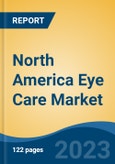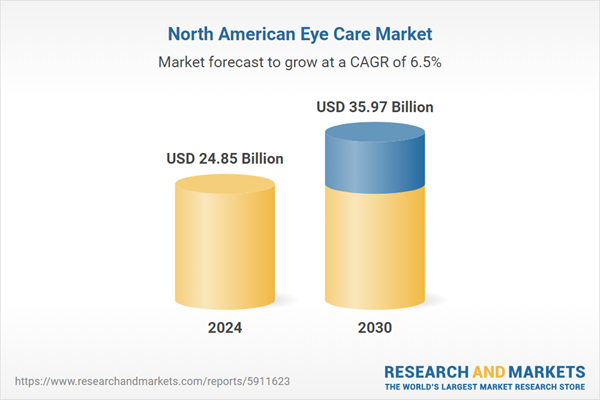Speak directly to the analyst to clarify any post sales queries you may have.
10% Free customizationThis report comes with 10% free customization, enabling you to add data that meets your specific business needs.
The North America Eye Care Market has consistently demonstrated robust growth over the years. For instance, according to the article published in 2023, as per the National Library of Medicine, cataracts are a major cause of visual impairment in older adults. Lens opacification is strongly linked to various geriatric conditions, including frailty, increased fall risk, depression, and cognitive decline. Additionally, the same source reports that in 2020, the primary causes of blindness worldwide among individuals aged 50 and older were cataracts, followed by glaucoma, uncorrected refractive errors, age-related macular degeneration, and diabetic retinopathy.
Also, according to a September 2023 news article from The Times of India, the outbreak of 'pink eye' led to a significant increase in ophthalmology medicine sales. In August, sales surged nearly 30% year-on-year for the second consecutive month, growing at almost five times the rate of the overall market. This sharp rise highlights the widespread incidence of conjunctivitis and related eye complications across the country in recent months. The market's expansion can be attributed to several factors, including an aging population, increasing awareness of eye health, technological advancements, and the growing demand for vision correction procedures. This market's growth trajectory is further fueled by innovations in diagnostic tools, pharmaceuticals, and surgical techniques.
Key Market Drivers
Technological Advancements: Pioneering Precision and Convenience
In the realm of eye care, technological advancements have proven to be a driving force like no other. These innovations have not only improved the quality of care but have also enhanced patient experiences. For instance, according to an October 2024 article published by Harvard Health, modern eye surgeries, though effective in treating conditions like cataracts and glaucoma, frequently result in complications such as dry eye disease. This condition, marked by a burning, gritty, or itchy sensation, can cause discomfort and deter some patients from undergoing surgery.LASIK (Laser-Assisted In Situ Keratomileusis) and similar procedures have gained widespread popularity. These treatments utilize laser technology to reshape the cornea, correcting refractive errors like nearsightedness, farsightedness, and astigmatism. Patients who undergo LASIK often experience rapid visual recovery and reduced dependence on glasses or contact lenses, leading to an improved quality of life. In an era marked by convenience and accessibility, telemedicine has transformed the way eye care is delivered.
Patients can now connect with ophthalmologists and optometrists remotely, allowing for timely consultations and follow-ups without the need for in-person visits. Telemedicine has been particularly beneficial for individuals in rural or underserved areas, ensuring they receive expert eye care services.
Key Market Challenges
Regulatory Challenges and Insurance Coverage
Complex regulatory frameworks and insurance coverage issues can pose challenges for both eye care providers and patients.The eye care industry is subject to stringent regulations, including licensing requirements, safety standards, and quality assurance measures. Compliance with these regulations can be time-consuming and costly for eye care practices. Insurance coverage for eye care services can be inconsistent, with some policies covering routine eye exams while others may not cover vision correction procedures like LASIK or specialty treatments.
Key Market Trends
Teleophthalmology and Remote Eye Care Services
Teleophthalmology, the practice of providing eye care services remotely through telecommunication technology, has witnessed significant growth in North America.Teleophthalmology enables patients to consult with eye care specialists from the comfort of their homes, reducing the need for in-person visits. Eye care professionals can conduct digital screenings and examinations to assess visual acuity, detect eye diseases, and monitor treatment progress.
Teleophthalmology addresses access disparities, extending eye care services to rural and underserved areas where ophthalmologists may be scarce. Patients can receive postoperative care instructions and follow-ups through virtual consultations, improving the overall patient experience. This trend enhances accessibility, convenience, and efficiency in eye care, contributing to the growth of the market. Teleophthalmology also aids in early disease detection and management.
Key Market Players
- Luxottica Retail North America Inc.
- Bausch Health Companies, Inc.
- Johnson & Johnson Vision Care, Inc.
- Alcon Laboratories, Inc.
- Hoya Vision Care North America
- CopperVision Inc.
- Menicon America, Inc.
- AbbVie Inc.
- Carl Zeiss Meditec AG.
F. Hoffmann-La Roche AG:
Genentech, IncReport Scope:
In this report, the North America Eye Care Market has been segmented into the following categories, in addition to the industry trends which have also been detailed below:North America Eye Care Market, By Product Type:
- Eyeglasses
- Contact Lens
- Intraocular Lens
- Eye Drops
- Eye Vitamins
- Others
North America Eye Care Market, By Coating:
- Anti-Glare
- UV
- Others
North America Eye Care Market, By Lens Material:
- Normal Glass
- Polycarbonate
- Trivex
- Others
North America Eye Care Market, By Distribution Channel:
- Retail Stores
- E-Commerce
- Clinics
- Hospitals
North Americ Eye Care Market, By Country:
- United States
- Canada
- Mexico
Competitive Landscape
Company Profiles: Detailed analysis of the major companies present in the North America Eye Care Market.Available Customizations:
With the given market data, the publisher offers customizations according to a company's specific needs. The following customization options are available for the report.Company Information
- Detailed analysis and profiling of additional market players (up to five).
This product will be delivered within 1-3 business days.
Table of Contents
Companies Mentioned
- Luxottica Retail North America Inc.
- Bausch Health Companies, Inc.
- Johnson & Johnson Vision Care, Inc.
- Alcon Laboratories, Inc.
- Hoya Vision Care North America
- CopperVision Inc.
- Menicon America, Inc.
- AbbVie Inc.
- Carl Zeiss Meditec AG.
- F. Hoffmann-La Roche AG: Genentech, Inc
Table Information
| Report Attribute | Details |
|---|---|
| No. of Pages | 120 |
| Published | March 2025 |
| Forecast Period | 2024 - 2030 |
| Estimated Market Value ( USD | $ 24.85 Billion |
| Forecasted Market Value ( USD | $ 35.97 Billion |
| Compound Annual Growth Rate | 6.5% |
| Regions Covered | North America |
| No. of Companies Mentioned | 10 |









